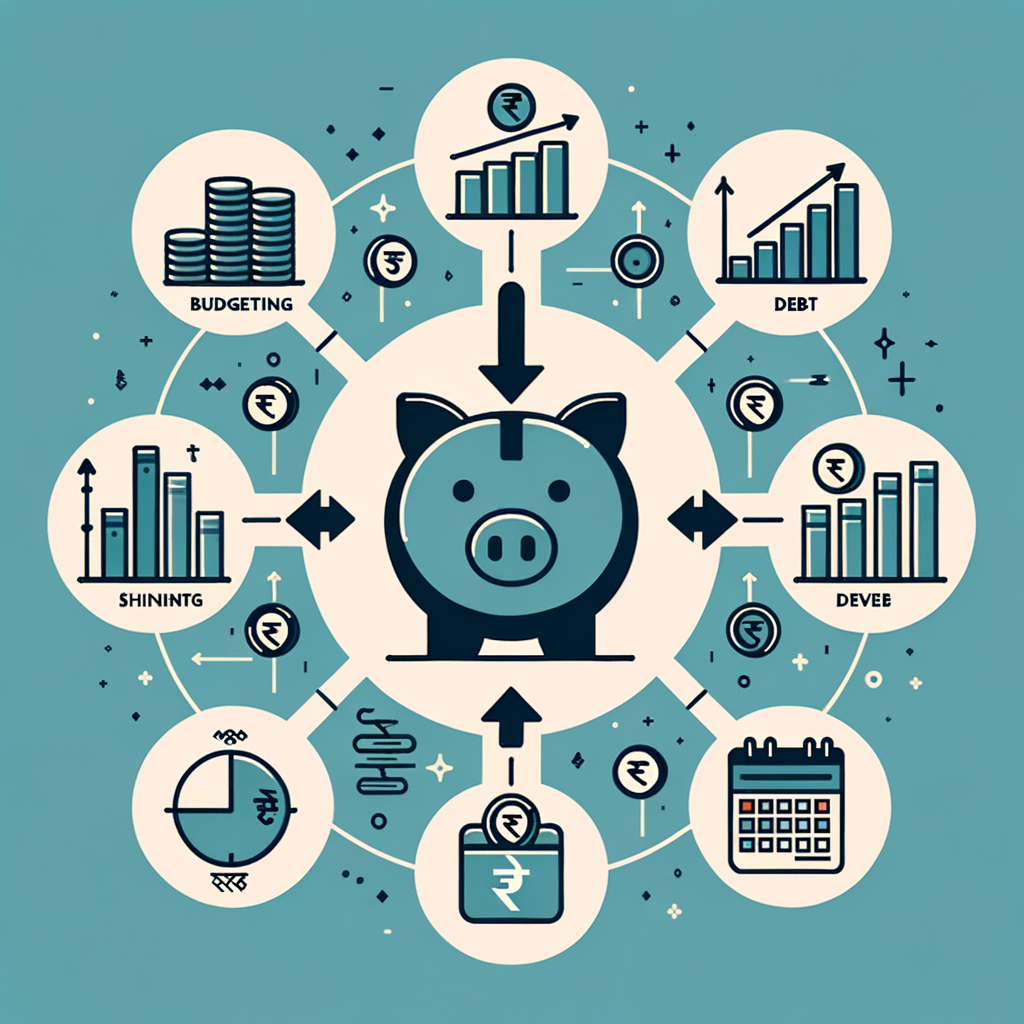Creating a Debt-Free Plan on a Tight Budget: An Indian Guide
Are you juggling the EMI for your home loan, the payment for your car, and the ever-rising credit card bills, all while trying to manage household expenses on a fixed salary? If this sounds familiar, you’re not alone. The constant pressure of debt can be overwhelming, making financial freedom feel like a distant dream. However, creating a successful debt-free plan isn’t a luxury reserved for the wealthy; it’s a completely achievable goal for any salaried individual or small business owner in India. The key lies not in a massive income, but in a smart strategy and consistent discipline. This comprehensive guide will walk you through understanding your exact debt situation, creating a practical budget that works for you, choosing a powerful repayment strategy, and finding the motivation to stick with it until you are finally free. With the right approach to financial planning on a tight budget India, you can take control of your money and build a secure future.
Step 1: Get a Crystal-Clear Picture of Your Debt
You cannot fight an enemy you don’t fully understand. The foundational first step towards any successful debt-free plan India is to confront the numbers and list out every single rupee you owe. This process might feel intimidating or even a little scary, but gaining this clarity is the most empowering action you can take. Ignoring the full picture only allows interest to silently accumulate in the background, making the problem worse. By bringing all your liabilities into the light, you transform a vague, stressful feeling into a concrete, manageable list of objectives. This isn’t about judging past financial decisions; it’s about drawing a clear line in the sand and preparing for a strategic attack on what you owe.
How to Create Your “Debt Masterlist”
To begin, open a fresh spreadsheet on your computer or simply take out a clean notebook. Your goal is to create a comprehensive inventory of your debts. Create columns with the following headings and fill in the details for every single loan or outstanding balance you have. Be thorough and brutally honest with yourself—this is a private document for your eyes only.
- Lender: Write down the name of the bank, NBFC, or individual you owe money to (e.g., HDFC Bank, Bajaj Finserv, a friend, a family member).
- Type of Debt: Specify the category of the loan (e.g., Credit Card, Personal Loan, Home Loan, Car Loan, Business Loan, Hand Loan).
- Total Outstanding Amount: List the full principal amount that is still left to be paid. You can find this on your latest loan statement or by logging into your account online.
- Interest Rate (p.a.): This is the most crucial piece of information. Find the annual percentage rate (APR) for each debt. For credit cards, this can be as high as 40%, while home loans might be around 8-9%.
- Minimum Monthly Payment (EMI): Note down the mandatory minimum amount you must pay each month to avoid penalties.
Pro-Tip: Remember to include everything. That small “buy now, pay later” balance, the loan from your sibling, and the outstanding amount on all of your credit cards must be on this list. A complete and honest masterlist is the map you will use to navigate your way out of debt.
Identifying “Good Debt” vs. “Bad Debt”
Not all debt is created equal. Understanding the difference can help you prioritize your repayment strategy. While the ultimate goal is to eliminate all liabilities, some debts are more destructive to your financial health than others.
- Good Debt: This is typically debt taken on to acquire an asset that has the potential to increase in value or generate income over time. It usually comes with a lower interest rate and can contribute to your long-term wealth. Examples in the Indian context include a Home Loan to buy a property or an Education Loan to invest in your career potential. Tax benefits also play a role, such as Section 24(b): Tax Deductions on Home Loan Interest Payments.
- Bad Debt: This is high-interest debt used to finance consumption or purchase items that lose their value quickly (depreciating assets). This type of debt actively drains your wealth through steep interest charges. Common examples include Credit Card debt for lifestyle expenses, high-interest Personal Loans for vacations or gadgets, and consumer durable loans.
Your immediate mission within your debt-free plan is to formulate an aggressive strategy to eliminate the “bad debt” as quickly as humanly possible, as it is the most significant drag on your financial progress.
Step 2: Build a Realistic Budget for Debt Reduction
If knowing your debt is the map, then your budget is the engine that will power your journey to financial freedom. Many people in India view budgeting as a restrictive exercise focused on what you can’t have. It’s time to flip that perspective. A budget is a powerful tool for empowerment; it’s about consciously telling your money where to go, instead of looking back at the end of the month and wondering where it all went. Creating a budget-friendly debt plan is about redirecting your income from less important areas towards your most important goal: becoming debt-free. It gives you control and transforms you from a passive spectator of your finances into an active, strategic commander of your resources. These budgeting tips for debt reduction India will form the core of your financial turnaround.
The Modified 50/30/20 Rule for Indians
The classic 50/30/20 rule is a popular starting point for budgeting. It suggests allocating your post-tax income as follows: 50% for Needs (rent/EMI, groceries, utilities, transportation), 30% for Wants (entertainment, dining out, shopping), and 20% for Savings & Investments.
However, when you are saddled with high-interest debt, this formula needs a strategic adjustment. We recommend a modified approach for those focused on debt repayment: the 50/20/30 (Needs/Wants/Debt Repayment & Savings) rule.
Under this model, your essential Needs still take up 50% of your income. The major shift happens in the other two categories. You intentionally shrink your “Wants” category down to just 20%. This requires conscious choices and some sacrifices, but it’s a temporary measure with a long-term reward. The freed-up 10%, combined with your original 20% for savings, creates a powerful 30% chunk of your income that can be aggressively directed towards destroying your debt.
Practical Tips to Cut Expenses and Find Extra Cash
Shrinking your “Wants” from 30% to 20% might seem daunting, but small, consistent changes can add up to a significant amount. Here are some India-specific tips to find that extra cash in your monthly budget:
- Review Your Subscriptions: Take a hard look at your monthly digital spending. Do you really need Hotstar, Netflix, Amazon Prime, SonyLIV, and Zee5 all at once? Tally up the total cost and choose to keep only one or two of your most-used services.
- Cook More, Order Less: The convenience of Zomato and Swiggy comes at a high price. Calculate how much you spent on food delivery last month. Challenge yourself to cut that amount by 50% or more by planning meals and cooking at home. This is often the single biggest area where urban Indians can save money.
- Optimize Your Utility Bills: Small habits make a big difference. Unplug electronics when not in use, switch to energy-efficient LED bulbs, and be mindful of your water consumption. These actions can shave a meaningful amount off your monthly electricity and water bills.
- Re-evaluate Phone & Internet Plans: Are you paying for data you don’t use? Telecom providers like Jio, Airtel, and Vi are constantly updating their plans. Take 30 minutes to compare your current plan with what’s available; you might find a cheaper plan that meets your needs perfectly.
- Implement a “Cooling-Off Period”: Impulse shopping on platforms like Amazon and Flipkart can wreck a budget. Institute a personal rule: for any non-essential purchase over ₹1,000, add it to your cart but wait a full 48 hours before you click “buy.” More often than not, the urge will pass, and you’ll have saved that money.
Step 3: Choose Your Weapon: Powerful Debt Elimination Methods
Once your new budget has successfully freed up a dedicated stream of cash for debt repayment, it’s time to decide how to deploy it for maximum impact. Simply making minimum payments will keep you in debt for years, sometimes decades. A focused strategy is essential. The two most popular and effective debt elimination methods for salaried individuals are the Debt Snowball and the Debt Avalanche. Choosing the right one for your personality is key to creating a debt repayment plan for Indian salaries that you can stick with for the long haul. Both methods require you to pay the minimum on all your debts, but they differ in how you allocate the extra money your budget has created. A detailed comparison can help you decide; learn more about Debt Snowball vs. Debt Avalanche: Which Strategy Is Best for You?.
The Debt Snowball Method (For Psychological Wins)
The Debt Snowball method focuses on building momentum through quick wins, which can be incredibly powerful for staying motivated. It prioritizes paying off your smallest debts first, regardless of their interest rates.
How it Works:
- Organize your “Debt Masterlist” from the smallest outstanding amount to the largest.
- Commit to paying the non-negotiable minimum monthly payment on all your debts.
- Take all the extra money you’ve freed up in your budget and throw it aggressively at the smallest debt on your list until it’s completely paid off.
- Celebrate this victory! You’ve eliminated one lender from your life.
- Now, “roll” the entire amount you were paying on that cleared debt (its minimum payment + all the extra cash) and add it to the minimum payment of the next-smallest debt. This creates a larger “snowball” of money attacking your debt.
- Repeat this process until you are completely debt-free.
Best For: This method is perfect for people who thrive on positive reinforcement. The psychological boost of crossing a debt off your list, even a small one, provides the fuel to keep going and tackle the larger debts.
The Debt Avalanche Method (To Save the Most Money)
The Debt Avalanche method is the most logical and mathematically sound approach. It prioritizes paying off debts with the highest interest rates first, which saves you the most money in interest payments over the life of your loans.
How it Works:
- Reorganize your “Debt Masterlist” from the highest interest rate (p.a.) to the lowest.
- As with the snowball, continue to pay the absolute minimum on all your debts to avoid penalties.
- Channel every extra rupee from your budget to attack the debt with the highest interest rate. This is usually credit card debt.
- Once that high-interest debt is eliminated, take the entire amount you were paying towards it (its minimum payment + your extra cash) and attack the debt with the next-highest interest rate.
- Continue this avalanche until all your debts are cleared.
Best For: This method is ideal for individuals who are driven by numbers and logic. If the thought of paying unnecessary interest bothers you more than the need for quick wins, the Avalanche will be more satisfying and financially efficient.
| Feature | Debt Snowball Method | Debt Avalanche Method |
|---|---|---|
| Strategy | Pay off smallest debts first | Pay off highest-interest debts first |
| Primary Focus | Behavioral & Motivational | Mathematical & Financial |
| Key Benefit | Quick psychological wins build momentum | Saves the most money on interest over time |
| Best For | People who need to see progress to stay motivated | People who are disciplined and focused on efficiency |
Should You Consider Debt Consolidation?
Debt consolidation is another strategy you might encounter. This involves taking out a single, new loan (usually a personal loan from a bank) to pay off several smaller, high-interest debts, like multiple credit card balances. The goal is to simplify your payments into one EMI and, crucially, secure a lower overall interest rate. This can be one of the more affordable debt management solutions, but it requires careful consideration.
- Pros: You only have to track one payment date (EMI) instead of several. If you can get a personal loan at 12-14%, you can use it to clear credit card debts that are charging you 30-40% interest, resulting in significant savings.
- Cons: To get a loan with a favorable interest rate, you need a good CIBIL score. More importantly, consolidation doesn’t address the spending habits that led to the debt in the first place. There’s a risk of paying off your credit cards with the loan and then running them up again, putting you in an even worse position.
Recommendation: Consider debt consolidation only if you can get a new loan with a significantly lower interest rate than your current average and you are absolutely committed to your new budget and will not accumulate new high-interest debt.
Conclusion: Your Path to a Debt-Free Life Starts Today
Achieving a debt-free life in India, especially when you’re working with a tight budget, is a marathon, not a sprint. It requires patience, discipline, and a clear strategy. However, it is far from impossible. By following the simple, powerful steps outlined in this guide, you can move from a position of financial stress to one of control and empowerment. Remember the process: first, gain absolute clarity by assessing every rupee you owe. Second, build a realistic budget that works for you by redirecting funds towards your goal. And third, consistently apply a chosen repayment strategy, whether it’s the motivational Snowball or the efficient Avalanche. Every extra payment you make, no matter how small it seems, is a concrete step towards your financial freedom. Your journey to a life without the burden of EMIs begins with the very next decision you make. Stick with your debt-free plan, and you will succeed.
Call to Action (CTA): Managing personal debt is the first step towards financial health. For small business owners, ensuring your company’s finances, GST, and taxes are managed professionally is just as critical. Let TaxRobo handle your compliance and accounting needs, so you can focus on growing your business. Contact us today for a free consultation!
Frequently Asked Questions (FAQs)
1. Should I stop investing in my PPF/mutual funds to pay off debt?
This is a common dilemma, and the answer depends on the interest rate of your debt. For high-interest debt like credit cards (which can charge 25-40% p.a.), it is almost always better to pause your investments temporarily and aggressively clear that debt. The interest you are paying far outweighs any potential returns from your investments. For low-interest “good debt” like a home loan (at 8-9% p.a.), it often makes more financial sense to continue with your SIPs and PPF contributions while paying your regular EMIs, as your investments have the potential to earn more than the interest on the loan over the long term.
2. How can I improve my CIBIL score while repaying debt?
Improving your CIBIL score while in repayment mode is entirely possible and happens naturally if you follow your plan. The single most important factor is making all your EMI and minimum credit card payments on time, every single time. Late payments are very damaging to your score. As you consistently pay down your total outstanding debt, your “credit utilization ratio” (the amount of credit you’re using vs. your total available credit) will decrease, which provides a significant boost to your score. The first step is to know where you stand; you can find out How to Track Your Credit History Using Your PAN Card Via CIBIL. Lastly, avoid applying for any new loans or credit cards while you are focused on repaying existing debt.
3. Is it a good idea to take a loan from a loan app to pay off another debt?
You should be extremely cautious with this approach. While some digital lending platforms are legitimate, many unregulated loan apps in India charge exorbitant interest rates, have numerous hidden fees, and are known to employ aggressive and sometimes illegal recovery tactics. This could easily trap you in a worse debt cycle. Before considering any such loan, always verify that the lender is an RBI-regulated entity. It is generally much safer to approach a reputable bank or NBFC for a proper debt consolidation loan.
4. What is the most common mistake people make in their debt-free plan?
The most common mistake is creating an unrealistic, overly restrictive budget. When you cut out every single “want” from your life and leave no room for even a small pleasure, you are setting yourself up for burnout. Living a miserable, deprived lifestyle is not sustainable. You are far more likely to abandon the plan altogether and revert to old habits. The key to a successful debt-free plan is consistency, not perfection. It’s better to have a slightly less aggressive plan that you can stick to for two years than a perfect plan that you abandon after two months. Allow for small, planned-for rewards in your budget to keep your motivation high.



